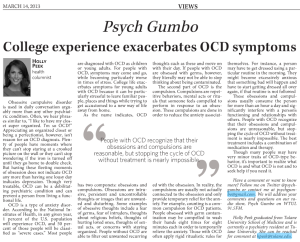Students should be aware of effects of MDMA
Pop culture icons such as Miley Cyrus, Madonna and Kanye West have glorified through their music the use of a popular drug called Molly, also known as MDMA or ecstasy. The drug has become very popular in the college party scene with a reported 5.8% of college students having used the drug in 2013. Although drug users often report a euphoric high from the drug, there is a dark side including serious physical and mental health risks. Check out my latest column to learn more!

How does social media make you feel?
Do you ever make a Facebook, Twitter or Instagram post and then keep checking the likes, favorites, and retweets? Are you annoyed by selfies, yet take many of your own? How great do all those birthday wishes on Facebook feel? And don’t you wish people would just stop posting about their fabulous vacations and engagement rings!?
Social media is a great way to keep in touch with friends, share good news and network for business. However, there is a dark side to social media. Check out my latest article in the Tulane Hullabaloo!
Self-injury is common and treatable in college
As a psychiatry resident working in New Orleans, I have the opportunity to treat a wide range of interesting people. I also have the great opportunity to work with college students when they show up to the Tulane emergency room in crisis. Something that I often see in these students and other young adults is a pattern of self-injury.
What may seem strange or scary to some, is a daily impulse for others. Check out my latest column in The Hullabaloo: 
Bipolar disorder can emerge in college students
“College is difficult for students suffering from bipolar disorder or mania. According to the National Institute of Mental Health, more than 50 percent of all cases of bipolar disorder onset between the ages of 15 and 25, and a patient’s first manic episode often occurs while in college. Late nights, stress, flexible schedules and exposure to drugs and binge drinking can trigger a manic or depressive state, particularly for people who have a genetic vulnerability to the disorder.”
Learn more about bipolar disorder in young adults in the latest article for The Hullabaloo:
For more information:
National Institute on Mental Health: Bipolar Disorder
Are we doing enough for mental health on college campuses?
Over the past several years, our nation has witnessed mass shootings and episodes of violence that have been committed by young, college aged adults. Among other issues such as gun control, this has brought to national attention the need for expanded mental health services on college campuses. It is estimated that one-fifth of college students will experience a mental illness. Furthermore, suicide is the second leading cause of death among college students. Despite the obvious and increasing need for mental health services, college campuses remain underfunded to provide adequate services to their students. Read my article in The Hullabaloo to learn more:
Other interesting articles:
Mental Health Breakdown: when Harvard fails its students
University mental health services strained under increased need
Colleges struggling with growing demand of mental health services
OCD: what it is and what it isn’t
“I’m so OCD!” is a phrase we may use from time to time when describing the fact we must have our closet clean, the crooked picture on the wall bothers us, or when the desk drawer has to be organized in a particular way. However, OCD stands for obsessive compulsive disorder and is often a misused term in daily conversation . OCD can be a very debilitating mental health condition and when left untreated it can be devastating for a patient and their families. OCD symptoms can be made worse in times of stress and is often diagnosed in childhood or early adulthood. Stressful transitions in college can also exacerbated symptoms of college students suffering from OCD. Read my latest article in The Hullabaloo to find out what OCD is, and what it isn’t!
Men Suffer from Eating Disorders Too
In recognition of National Eating Disorders Awareness Week, I wanted to highlight an important yet often ignored aspect of eating disorders. The number of men suffering from body image issues and eating disorders is growing, however, many men do not seek treatment because eating disorders are often viewed as a “female issue.” Recently at Paris Fashion Week, dangerously thin appearing male models were seen walking the runway, launching a social media firestorm discussing men and eating disorders. More men are also suffering from “muscle dysmorphia.” Learn more in my article from The Hullabaloo:
National Association for Males with Eating Disorders
“Manorexia” on the rise: men with eating disorders face stigma with getting treatment
College Psychostimulant Abuse Proves Dangerous
Psychostimulants, such as Adderall or Ritalin, are one of the most abused legal drugs on college campuses. These drugs have become very prevalent within the college culture nationwide, particularly in high achieving students in professional schools. Although they prove to be helpful when properly prescribed to ADHD patients, they can also be very dangerous to those who misuse them. Check out my article in The Hullabaloo to learn more:













